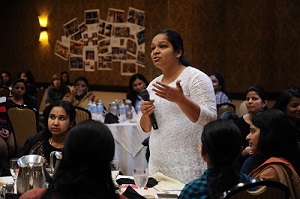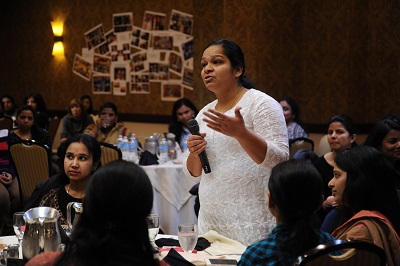There are situations where you want to know something, but you don’t want to ask a question because you are unsure what the other person will say. In these situations, it is possible with a few tricks to transform your question so that it is no longer a question, but the other person’s response still answers your actual question.

A proven tactic to ask a question without asking a question is to use reflective listening, such as repeating the last words your colleague said to you and turning each question into a statement by saying “I feel…” or “I wonder…”.
Reasons to Avoid Questions
You might not want to ask a question for one of several reasons: there may be a perceived vulnerability by asking questions, such as in a lecture hall on a University campus, questions may limit the conversation potential, and/or questions can be misinterpreted.
Perceived Vulnerability
A perceived vulnerability is the belief that you will be hurt if you ask a question, whether physically, emotionally, or socially, and the consequence of being hurt may be real, imaginary, or fear of repetition from a previous bad experience when asking a question.
Studies indicate that the most prevalent reason that stops people from asking questions is that they don’t want to feel rejected, dismissed, or experience perceptual backlash. [1]
All of these emotions, such as rejection, are very real feelings of hurt that are processed in the human brain and body. To protect itself, the brain may lean toward a pattern of asking fewer questions if it feels under threat.
It Limits Your Conversation Potential
The first question asked when sitting down for a discussion with a colleague or a partner can determine the topic for the rest of the conversation. This is detrimental if the other person has something they need to say, but the conversation topic never moves into what they want to talk about.
Misinterpreted Questions
Sometimes a direct question as innocent as “What are you doing?” can come across as blameful or accusatory to the recipient, and they may interpret it as “Why aren’t you doing something else?” or “Why are you wasting your time with this?”
Misinterpreted questions can lead to defensiveness and criticism from your colleague or partner, and it can be difficult to know which questions will be favorably received.
How to Ask a Question Without Asking a Question
The easiest way to ask a question without asking a question is to actively listen to your colleague, family member, or partner using the four types of reflective listening.
Additionally, if you need to start a discussion or want to solicit information, use ‘I’ statements and observation statements.
The Four Types of Reflective Listening
The four types of reflective listening are verbatim, translational, feelings, and connecting the dots. They allow you to respond to your colleague or partner smartly, without sounding like you’re asking questions, which allows for a flowing conversation.
These types of listening can be used if you are in a situation where you don’t want to ask any questions or don’t want to continue a conversation with phrased questions that sound like statements.
Verbatim Listening
Verbatim listening is reflecting the words of your partner or colleague back at them in the form of a statement. It allows you to ask a question without asking a question that propels the conversation forward.
The first time you try this might feel funny, but you’ll be surprised how often people will say “Yes, you understand what I’m talking about”, or “That is not what I meant” when you repeat their own words back to them.
Example:
If your colleague or partner says “I’m learning about how to make a DIY terrarium,” instead of replying “Cool, how do you make one?” you can instead say “How to make a DIY terrarium…” and pause. They will fill in the space and tell you more about their terrarium.
Translational Listening
Translational listening is similar to verbatim listening, except you change up the wording slightly so it sounds like you’re really listening while maintaining a statement without a question mark.
Example:
If someone is telling you how they lost their wallet, broke their favorite vase, and dropped their toast butter side down, instead of saying “Aw, are you okay?” you can say “It sounds like you’re having an awful time.”
‘Feelings’ Listening
‘Feelings’ listening takes the underlying emotions of your partner or colleague and gives them back to them in the form of a statement.
Example:
If your colleague is telling you how they started talking to a new person, they’re fun and they make them laugh, and they have plans to go out for lunch later that week, instead of saying “Are you in love?” you can say “Sounds to me you like this person.”
Connecting the Dots
‘Connecting the dots’ listening is the highest level of statement listening, and allows you to take pieces of information from earlier in the conversation, and connect it with a piece later in the conversation in the form of a responding statement.
Example:
If you have a friend who told you previously that they’re waiting to seal a deal with a big company, and they drive up to your place sometime later in a new sports car, you can ‘connect the dots’.
Instead of saying “So how did that deal go?” you can say “Looks like your deal went through, congratulations.”
Turn Any Question into a Statement Using ‘I’ Statements
Take your question, focus on its topic, and rephrase it to start with “I…” in a way that you’re stating your question instead of adding a question mark at the end.
As it’s not the normal way we think, it can be difficult at first to switch a question into a statement. The best way to practice this is to be mindful of what you’re about to ask, take your conversation slow, and rephrase it in your head first.
‘I’ Statement Examples
| Question | ‘I’ Statement |
| What is the weather like outside? | I wonder what the weather is like outside. |
| What time is it? | I wish I knew what time it was. |
| What is for dinner? | I’m curious about what’s for dinner. |
Use Observation Statements Instead of Asking Questions
This is a level up from ‘I’ statements as it allows you to state anything in a way that encourages your partner, colleague, or stranger to offer an answer voluntarily and engagingly.
Statements can be more engaging than the same questions over and over again and can improve your conversational skills greatly.
Observation Statement Examples
| Question | Observation Statement |
| How was your fishing trip? | You seem like you really enjoyed your fishing trip. |
| What is your field of work? | Let me guess, you work in IT. |
| Where’s your favorite place to eat? | Judging from the decor, you’re a big fan of ‘50s styled shakes and fries. |
Example Phrases To Use
This list of example phrases will help you formulate statements and ask questions without asking questions:
“I think…”
“I wonder…”
“I know…”
“I feel…”
“I worry that…”
“I would like…”
“I bet…”
“You know…”
“Please tell me…”
“You look like…”
“You’re curious…”
“You’re considering…”
“That’s what you’re saying…”
“It’s crucial to you…”
“What I’m getting at is…”
“From your point of view, everything appears…”
“It appears as if…”
Take Action
The best way to take action on asking questions without asking questions is to pick two or three of the above phrases and put them in your conversation toolkit and become more aware of the questions you ask, and when you ask them.
Write down your hand-picked phrases that are not in your normal vocabulary and incorporate them into small, daily conversations.
You can also make a habit to notice every time you ask a question in a conversation. The trick is to simply notice so that, eventually, you can catch yourself, rephrase the question, and instead say a statement on the same topic.
Sources:
[1]: https://behavioralscientist.org/who-asks-questions-and-what-it-tells-us/

Sophie Hammond is a journalist, psychologist, and freelance speechwriter for people in politics and business. She lives on the edge of the Rocky Mountains with her dog and a lifetime supply of books. When she’s not writing, she can be found wandering through nature or journaling at a coffee shop.

